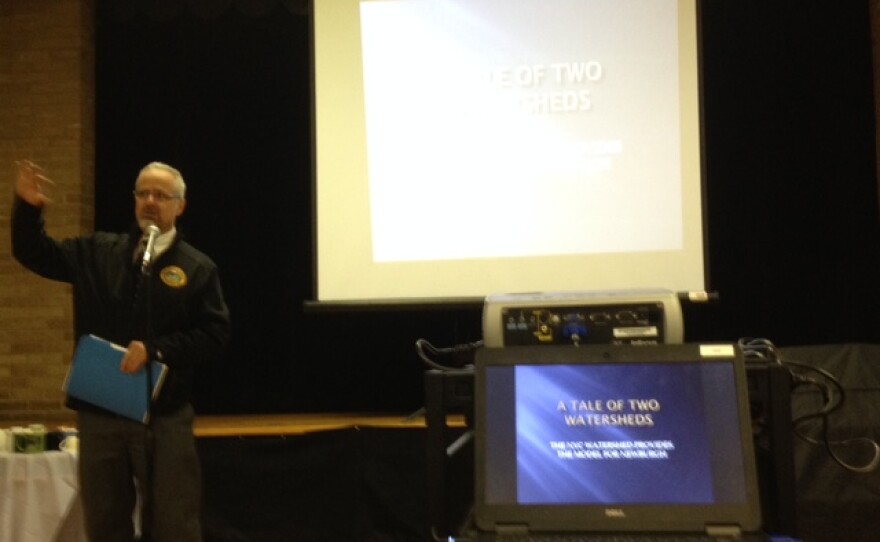As officials continue grappling with the PFOS water contamination issue in Newburgh, thoughts are turning to the distant future — to creating a watershed model replicable throughout New York.
During a meeting June 5, state and city officials delivered updates to the Newburgh community on PFOS contamination and the blood testing program. Newburgh City Manager Michael Ciaravino opened the meeting with his presentation entitled “A Tale of Two Watersheds.”
“What I’m noticing is that, even with this crisis, I would expect that we would already have a lot more momentum around the urgency and the need to do something differently,” says Ciaravino.
He said Newburgh is in need of updated watershed protection regulations; a land acquisition program to protect sensitive source areas; and state funding to compensate towns for any lost development.
“New York City has, by all accounts, some of the best water not only in the country, but in the world. Why can’t we borrow from their model? It seems in many ways to be a no-brainer. In a sense, the work has already been done. The regulations have already been written. The political lift has already occurred. And since there are so many cities in the state of New York that are similar to the City of Newburgh in that they have a water reservoir that’s located outside of their political jurisdiction, that maybe this isn’t just one thing for Newburgh, it’s something that can apply to all of these communities throughout the state of New York.”
Dan Shapley is water quality program director for Riverkeeper. He also believes the New York City model can be applied in communities around the state, including Newburgh.
“It takes political will and it takes dedication and focus on the outcome that we need to achieve, which is protecting a city’s drinking water supply. It’s as fundamental as that,” says Shapley. “If we’re going to have a Newburgh in 100 years, it needs to have drinking water. So this is not going to be a 1-year project or a 2-year project. We’re probably talking about a 30-year, 50-year project.”
New York state Department of Environmental Conservation Deputy Commissioner Martin Brand notes the New York City watershed is much larger and encompasses a number of different communities and conditions, including the Catskills, though it could be useful for Newburgh to consider lessons learned.
“It’s hard to make a direct comparison but certainly the philosophy that was used in the New York City watershed for protection of land, identification of problem areas, coming up with a proactive plan that can guide your activities moving forward, guide development, guide permitting, give a tool to local planning units and municipalities to move forward so they can make good decisions that will affect the water quality in the future,” Brand says. “So, it’s certainly the lessons we learned in the New York City watershed can be applied directly here.”
Meanwhile, the state budget funds source water assessment programs. Brand says the state had already started one in Newburgh.
“And we’re looking at the characteristics of the Lake Washington watershed to not only identify problem areas, things that we need to look at and take care of on a more immediate basis, but actually come up with a plan moving forward so we can have a proactive way to protect the water supply moving into the future so we’re not in a reactive mode when situations arise, but we can actually proactively plan for the future so we can address things like emerging contaminants and other water supply issues as they come along,” Brand says.
Riverkeeper has been compiling a report on the topic.
“We will be putting on paper a number of recommendations for how the drinking source water assessment and protection plan for the City of Newburgh can be comprehensive and can be a model for the state, for other communities around the state,” Shapley says. “We know that the DEC is really headed in that direction anyway to try and make this a model for the state, which we really desperately need, we need better drinking water protections statewide, so we’re going to be trying to support them and also challenge them to really achieve that.”
Again, Ciaravino.
“And at the end of the day, if we aren’t able to have water that we can all drink, then humanity will have failed its final exam.”
PFOS contamination in Newburgh’s main drinking water source – Washington Lake —was discovered in May 2016. In August, New York state declared Stewart Air National Guard Base a Superfund site, having identified the base as a significant source of the PFOS contamination found in Washington Lake. Federal and state officials have been pressing the Department of Defense to take responsibility for the contamination ever since.










